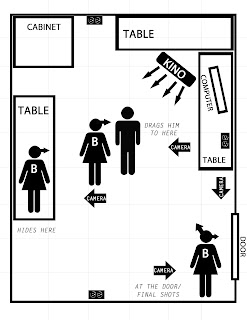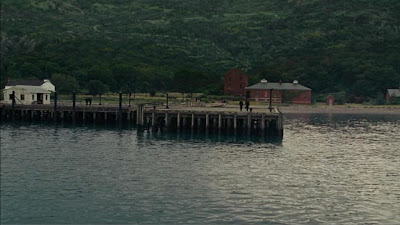In preparation for shooting my scripted scene assignment, I've compiled a production notebook that contains everything I'll need to stay organized on set and to ensure that the shoot goes smoothly. Inside are the script, shooting script, room layout and lighting plan, shot list, foley list, storyboard, and more.
The shooting script in my book has been annotated with shot numbers so that we can keep up with what's been covered already and what we need to shoot next.
For me, one of the greatest benefits of extensive pre-production planning is storyboarding. I always try to visit the location before the shoot to map out the lay of the room and spot available electrical outlets. I like to pace off the room to get a feel for its general dimensions, then map the whole thing out roughly in Photoshop or in 3D in Google Sketchup or FrameForge.
Once this is done, it's much easier to get a feel for the blocking and to quickly make decisions about lighting placement and such. Once you have a rendering of the room in front of you, problems with the space become much more apparent, saving you the time of running into those problems unexpectedly while you have crew standing around waiting to shoot.
After the room has been mapped, I usually get to work on a storyboard and sketch out a basic version of the types of shots I'd like to see. It is usually during this process that I feel I get the most inspiration as far as camera work is involved because I can see the composition of each shot as a tangible thing, juxtaposed together, in a way that lets me start editing the film in my head and working out the flow of the various sequences.
I also find that storyboarding helps me to start identifying a concrete visual style for the project, as the tone and emotion of the scenes tend to influence the way in which I draw the cells. I can't stress enough the importance of storyboarding in my particular creative process. For me, it's the stage where the idea becomes a visual reality for the first time.
This is a blog that was created as a requirement for the TCF 312 Advanced Videography course at the University of Alabama with Dr. Rachel Raimist.
Sunday, March 25, 2012
Thursday, March 15, 2012
#10: Motivated Movement
This is a great example of effective motivated movement from Kill Bill, a film with some all around great cinematography.
This is one long extended take with the occasional hidden cut, achieved with careful choreography and extensive use of heavy equipment to control the movement of the camera. It does a good job of pulling the viewer in, giving them an all-seeing omnipotent view of the action taking place within the location for the scene.
The camera floats along, following Uma Thurmon's character as she infiltrates the House of Blue Leaves. It varies quickly from sweeping wide shots to tight close ups simply by reframing or moving in closer to a character. By the end of the impressive sequence, the viewer has been taken on a full 360 view of the space where a big showdown battle is about to occur, effectively selling the geography of the space and the reality of the fictional world contained within.
This is one long extended take with the occasional hidden cut, achieved with careful choreography and extensive use of heavy equipment to control the movement of the camera. It does a good job of pulling the viewer in, giving them an all-seeing omnipotent view of the action taking place within the location for the scene.
The camera floats along, following Uma Thurmon's character as she infiltrates the House of Blue Leaves. It varies quickly from sweeping wide shots to tight close ups simply by reframing or moving in closer to a character. By the end of the impressive sequence, the viewer has been taken on a full 360 view of the space where a big showdown battle is about to occur, effectively selling the geography of the space and the reality of the fictional world contained within.
Thursday, March 1, 2012
#8 Scene Analysis - Shutter Island
In this opening scene from the film Shutter Island, we start out with a practically blank screen.
 We discover that this is a field of fog as a boat emerges slowly.
We discover that this is a field of fog as a boat emerges slowly. From here, we cut into the interior of the boat to find our main character suffering from sea sickness.
From here, we cut into the interior of the boat to find our main character suffering from sea sickness.  We move into a closer shot where we see the face of Teddy for the first time, reflected in a mirror. The mirror is used a lot throughout the film and can represent the character's mental state as he searches within himself for meaning, and later in the film, searches for his very identity.
We move into a closer shot where we see the face of Teddy for the first time, reflected in a mirror. The mirror is used a lot throughout the film and can represent the character's mental state as he searches within himself for meaning, and later in the film, searches for his very identity. 
Teddy then turns and loks out of a porthole, and we see the expanse of water through a frame within a frame. We later find that Teddy feels trapped emotionally, and later he is trapped literally on an island, so there is significance in the use of the window and the water that surrounds them (and later the island).
 Teddy throws water on himself, perhaps symbiotically trying to wash away his own sins.
Teddy throws water on himself, perhaps symbiotically trying to wash away his own sins.  In the next shot, we see objects hanging in the foreground that appear to be shackles, drawing the audience into the story by piquing their curiosity as to why the chains and cuffs are even present on the boat.
In the next shot, we see objects hanging in the foreground that appear to be shackles, drawing the audience into the story by piquing their curiosity as to why the chains and cuffs are even present on the boat. Teddy emerges from another frame within a frame, adding weight to his emergence from the private space within the boat to the more public space without.
Teddy emerges from another frame within a frame, adding weight to his emergence from the private space within the boat to the more public space without.
From a POV shot, we see another man on the boat through a fence that could, again, symbolize Teddy's sense of being trapped. The expanse of water beyond the edge of the boat helps to show how isolated the characters are.
 From a medium wide shot, we see Teddy approach this other man. The sky is dark and overcast and the colors are muted, adding to the general atmosphere of the story.
From a medium wide shot, we see Teddy approach this other man. The sky is dark and overcast and the colors are muted, adding to the general atmosphere of the story. We move to a medium 2 shot as Teddy gets closer to the other man and they become more personal with one another.
We move to a medium 2 shot as Teddy gets closer to the other man and they become more personal with one another. This shot is followed by a reverse medium wide shot where the audience can again see that the characters are surrounded by water on all sides.
This shot is followed by a reverse medium wide shot where the audience can again see that the characters are surrounded by water on all sides. As the two characters get acquainted, we move in a little closer. Notice that the new character is more resolute, standing at the front of the boat, while Teddy is less committed, hanging back slightly and never seeming comfortable within the frame. The other man looks ahead in the direction of travel, while Teddy looks all around and seems nervous.
As the two characters get acquainted, we move in a little closer. Notice that the new character is more resolute, standing at the front of the boat, while Teddy is less committed, hanging back slightly and never seeming comfortable within the frame. The other man looks ahead in the direction of travel, while Teddy looks all around and seems nervous.
 We move in to an even closer two shot as the space becomes more personal while the two men share details about themselves.
We move in to an even closer two shot as the space becomes more personal while the two men share details about themselves.  The other man asks Teddy if he has a girlfriend or a wife, at which point we cut to a flashback. Teddy's wife is seen holding a tie and walking across the floor to him.
The other man asks Teddy if he has a girlfriend or a wife, at which point we cut to a flashback. Teddy's wife is seen holding a tie and walking across the floor to him. Here, her bare feet show that she is relaxed and comfortable in the environment as she approaches Teddy from behind.
Here, her bare feet show that she is relaxed and comfortable in the environment as she approaches Teddy from behind. In this two shot, the characters are comfortable and balanced and the lighting is very warm and soft, giving a sense of serenity and happiness.
In this two shot, the characters are comfortable and balanced and the lighting is very warm and soft, giving a sense of serenity and happiness.
We move in even closer to see the peaceful and happy expression on her face.
 Suddenly, reality comes crashing back in like the waves of the sea and we cut to a dark shot of churning sea water and return to the previous location.
Suddenly, reality comes crashing back in like the waves of the sea and we cut to a dark shot of churning sea water and return to the previous location. Here, Teddy is isolated and framed alone as he remembers his wife and seems to be contemplative, his eyes set just above the horizon line. Also, Teddy is looking in the direction opposite of the direction of travel of the boat, back into the past and his memories, and also in the direction where his wife was located in the previous flashback.
Here, Teddy is isolated and framed alone as he remembers his wife and seems to be contemplative, his eyes set just above the horizon line. Also, Teddy is looking in the direction opposite of the direction of travel of the boat, back into the past and his memories, and also in the direction where his wife was located in the previous flashback.
We cut to the mysterious and foreboding titular island as it looms threateningly in the distance in this very wide shot. The lighting frames up the island nicely and its placement on the upper third makes it seem imposing.
 When the captain of the boat arrives to speak with the men, he is set lower in the frame than the other two men because he is less important to the plot.
When the captain of the boat arrives to speak with the men, he is set lower in the frame than the other two men because he is less important to the plot.
Subscribe to:
Comments (Atom)












